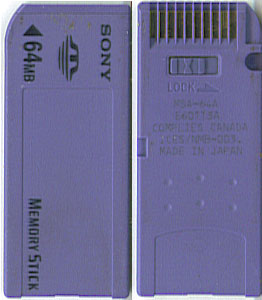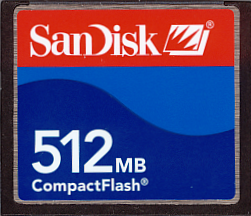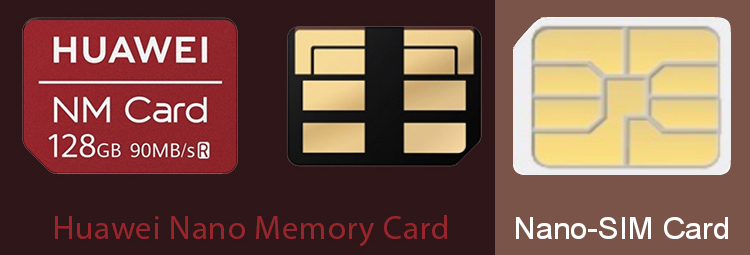Memory card


A memory card is an electronic data storage device used for storing digital information, typically using flash memory. These are commonly used in digital portable electronic devices, such as digital cameras as well as in many early games consoles such as the Neo Geo. They allow adding memory to such devices using a card in a socket instead of protruding USB flash drives.[1]
Common types of flash memory card include SD cards (including microSD), Sony's Memory Stick and CompactFlash.[2] As of 2024[update], SD cards are the most common type of memory cards.
History
The basis for memory card technology is flash memory.[3] It was invented by Fujio Masuoka at Toshiba in 1980[4][5] and commercialized by Toshiba in 1987.[6][7]
The development of memory cards was driven in the 1980s by the need for an alternative to floppy disk drives that had lower power consumption, had less weight and occupied less volume in laptops. Some were also marketed as a lower cost alternative to ROM cartridges.[8] Several competing and incompatible memory card formats were developed by several vendors,[9] such as for example the Bee Card, Astron SoftCards,[10] Sega Cards, NEC UltraLite memory cards,[11][12] and the Mitsubishi Melcard which came in variants using 60 and 50 connector pins. The Sega Card was developed as a cheaper alternative to game cartridges.[13] Some memory cards were used for memory expansion in laptops.[14][15][16]
JEIDA, the
Some early memory cards used
In 1994, memory card formats smaller than the PC Card arrived. The first one was
However, by 2005, SD and similar MMC cards had nearly taken over SmartMedia's spot, though not to the same level and with stiff competition coming from Memory Stick variants, as well as CompactFlash. In industrial and embedded fields, even the venerable PC card (PCMCIA) memory cards still manage to maintain a niche, while in mobile phones and PDAs, the memory card has become smaller.[citation needed]
Initially memory cards were expensive, costing US$3 per megabyte of capacity in 2001;
New products of Sony (previously only using Memory Stick) and Olympus (previously only using XD-Card) have been offered with an additional SD-Card slot beginning in 2010.[24] Effectively the format war has turned in SD-Card's favor.[25][26][27]
Data table of selected memory card formats
This section needs expansion with: info on which of these are dead. You can help by adding to it. (December 2021) |
| Name | Abbreviation | Form factor (mm) | DRM |
|---|---|---|---|
| PC Card | PCMCIA | 85.6 × 54 × 3.3 | No |
| CompactFlash I | CF-I | 43 × 36 × 3.3 | No |
| CompactFlash II | CF-II | 43 × 36 × 5.5 | No |
| CFexpress Type A | CFA | 20 × 28 × 2.8 | Unknown |
| CFexpress Type B | CFX | 38.5 × 29.8 × 3.8 | Unknown |
| CFexpress Type C | ? | 54 × 74 × 4.8 | Unknown |
| SmartMedia | SM/ SMC | 45 × 37 × 0.76 | ID |
| Memory Stick | MS | 50.0 × 21.5 × 2.8 | MagicGate |
| Memory Stick Duo | MSD | 31.0 × 20.0 × 1.6 | MagicGate |
| Memory Stick Pro Duo | MSPD | 31.0 × 20.0 × 1.6 | MagicGate |
| Memory Stick Pro-HG Duo | MSPDX | 31.0 × 20.0 × 1.6 | MagicGate |
| Memory Stick Micro M2 | M2 | 15.0 × 12.5 × 1.2 | MagicGate |
| Miniature Card | ? | 37 × 45 × 3.5 | No |
Multimedia Card |
MMC | 32 × 24 × 1.5 | No |
Reduced Size Multimedia Card |
RS-MMC | 16 × 24 × 1.5 | No |
MMCmicro Card |
MMCmicro | 12 × 14 × 1.1 | No |
| Nintendo Switch | NS | 31 × 21 × 3 | ? |
| P2 card | P2 | 85.6 × 54 × 3.3 | No |
| PS Vita | PSV | 30 x 22 x 2 | ? |
| SD card | SD | 32 × 24 × 2.1 | CPRM
|
| SxS | SxS | 75 × 34 × 5 | No |
| Universal Flash Storage | UFS | ? | Unknown |
broken anchor ] |
microSD | 15 × 11 × 0.7 | CPRM
|
| xD-Picture Card | xD | 20 × 25 × 1.7 | No |
| Intelligent Stick | iStick | 24 × 18 × 2.8 | No |
| Serial Flash Module | SFM | 45 × 15 | No |
| μ card | μcard | 32 × 24 × 1 | Unknown |
| NT Card | NT NT+ | 44 × 24 × 2.5 | No |
| XQD card | XQD | 38.5 × 29.8 × 3.8 | Unknown |
| Nano Memory card | NM Card | 12.3 × 8.8 × 0.7 | Unknown |
-
Secure Digital card(SD)
-
MiniSD cardwith an SD card adapter
-
CompactFlash (CF-I)
-
MultiMediaCard (MMC)
-
NM card (a proprietary memory card format created by Huawei) Electronic contacts compared to nano-sim card to the same scale
Overview of all memory card types
- PCMCIA ATA Type I Card (PC Card ATA Type I)
- PCMCIA Type II, Type III cards
- CompactFlash Card (Type I), CompactFlash High-Speed
- CompactFlash Type II, CF+(CF2.0), CF3.0
- Microdrive
- CFexpress
- MiniCard (MiB)
- SmartMedia Card (SSFDC) (max 128 MB) (3.3 V,5 V)
- xD-Picture Card, xD-Picture Card Type M
- Memory Stick, MagicGate Memory Stick (max 128 MB); Memory Stick Select, MagicGate Memory Stick Select ("Select" means: 2x128 MB with A/B switch)
- SecureMMC
- Secure Digital(SD Card), Secure Digital High-Speed, Secure Digital Plus/Xtra/etc (SD with USB connector)
- miniSD card
- microSDcard (aka Transflash, T-Flash, TF)
- SDHC
- WiFi SD Cards (SD Card With WiFi Card Built in) Powered by Device. (Eye-Fi, WiFi SD, Flash Air)
- Nano Memory (NM) card
- MU-Flash (Mu-Card) (Mu-Card Alliance of OMIA)
- C-Flash
- SIMcard (Subscriber Identity Module)
- Smart card (ISO/IEC 7810, ISO/IEC 7816 card standards, etc.)
- UFC (USB FlashCard) (uses USB)
- FISH Universal Transportable Memory Card Standard (uses USB)
- Intelligent Stick (iStick, a USB-based flash memory card with MMS)
- SxS (S-by-S) memory card, a new memory card specification developed by Sandisk and Sony. SxS complies to the ExpressCard industry standard.[28]
- Nexflash Winbond Serial Flash Module (SFM) cards, size range 1 MB, 2 MB and 4 MB.
Comparison
| Standard | SD | UFS Card | CFast
|
XQD
|
CFexpress | |||||||||
|---|---|---|---|---|---|---|---|---|---|---|---|---|---|---|
| Version | 3.0 | 4.0 | 6.0 | 7.0[29] | 8.0 | 1.0 | 2.0 | 1.0 | 2.0 | 1.0 | 2.0 | 1.0 | 2.0 | 4.0 |
| Launched | 2010 Q2 | 2011 Q1 | 2017 Q1 | 2018 Q2 | 2020 Q1 | 2016 Q2 | ? | 2008 Q3 | 2012 Q3 | 2011 Q4 | 2014 Q1 | 2017 Q2 | 2019 Q1 | 2023 Q3 |
| Bus | UHS-I | UHS-II | UHS-III | PCIe 3.0 x1 | PCIe 4.0 x2 | UFS 2.0 | UFS 3.0 | SATA-300 | SATA-600 | PCIe 2.0 x1 | PCIe 2.0 x2 | PCIe 3.0 x2 | PCIe 3.0 x1/x2/x4 | PCIe 4.0 x1/x2/x4 |
| Speed
(full-duplex) |
104 MB/s | 156 MB/s | 624 MB/s | 985 MB/s | 3938 MB/s | 600 MB/s | 1200 MB/s | 300 MB/s | 600 MB/s | 500 MB/s | 1000 MB/s | 1970 MB/s | up to 4 GB/s | up to 8 GB/s |
Video game consoles
This section needs additional citations for verification. (December 2011) |
Many older
Until the
Home consoles commonly use hard disk drive storage for saved games and allow the use of USB flash drives or other card formats via a memory card reader to transport game saves and other game information. Though some consoles have implemented cloud storage saving, most portable gaming systems still rely on custom memory cartridges to store program data, due to their low power consumption, smaller physical size and reduced mechanical complexity.
-
Neo Geo 2 KiB memory card
-
PlayStation 128 KiB memory card
-
GameCube 512 KiB memory card
-
Xbox 360 memory card
See also
References
- ISBN 978-93-5199-433-6.
- ^ Williams, Matt (April 27, 2022). "A Complete Guide to Memory Cards". PetaPixel. Retrieved April 27, 2025.
- ISBN 9789048194315.
- ^ Fulford, Benjamin (24 June 2002). "Unsung Hero". Forbes. Archived from the original on 3 March 2008. Retrieved 18 March 2008.
- ^ US 4531203 Fujio Masuoka
- ^ "1987: Toshiba Launches NAND Flash". eWeek. April 11, 2012. Retrieved June 20, 2019.
- ^ "1971: Reusable Semiconductor ROM Introduced". Computer History Museum. Retrieved June 19, 2019.
- ^ "What MSX? (GB)". 1985 – via Internet Archive.
- ^ "In The Cards". InfoWorld. InfoWorld Media Group, Inc. February 5, 1990. p. 25 – via Google Books.
- ^ "MSX Computing (GB) : Haymarket Publishing : Free Download, Borrow, And Streaming : Internet Archive". 1984.
- ^ Machrone, Bill (November 15, 1988). "NEC's 4.4-Pound UltraLite Sets a New Standard for Portable Machines". PC Magazine. Ziff Davis, Inc. pp. 33, 35.
- ^ Dryden, Patrick (October 30, 1989). "Vendors Move to Set IC Card Standards". InfoWorld. InfoWorld Media Group, Inc. p. 21 – via Google Books.
- ISBN 978-1-311-08082-0– via Google Books.
- ^ http://www.bitsavers.org/pdf/mitsubishi/Mitsubishi_VLSI_MOS_Memory_RAM_ROM_and_Memory_Cards_Jan91.pdf [bare URL PDF]
- ^ Rosch, Winn (January 26, 1993). "PCMCIA: The Expansion System of the Future". PC Magazine. Ziff Davis, Inc. p. 321 – via Google Books.
- ^ ISBN 978-0-201-40991-8– via Google Books.
- ^ https://www.cqpub.co.jp/hanbai/books/49/49971/49971_1syo.pdf [bare URL PDF]
- ^ a b Rist, Oliver (December 21, 1993). "PCMCIA: An Inside Look". PC Magazine. Ziff Davis, Inc. p. 264 – via Google Books.
- ^ a b Stam, Nick (December 21, 1993). "PCMCIA's System Architecture". PC Magazine. Ziff Davis, Inc. p. 270 – via Google Books.
- ^ "What MSX? (GB)". 1984.
- ^ a b "25 Years of CompactFlash: A Look Back at the Pioneering Format". PCMAG.
- ^ Corporation, Bonnier (May 27, 2000). "Popular Science". Bonnier Corporation – via Google Books.
- ^ "PCWorld.com – DataPlay Shows Breakthrough in Storage Media". June 8, 2001. Archived from the original on June 8, 2001.
- ^ Grunin, Lori (January 6, 2010). "Sony Does SD; Panasonic Intros First SDXC Cards | 2010 CES — CNET Blogs". Ces.cnet.com. Archived from the original on March 24, 2010. Retrieved January 7, 2013.
- ^ "Format-Krieg entschieden: SD-Card setzt sich durch" ("format-war resolved: SD-card prevails"), Chip-online, 14. January 2010
- ^ "Camera trends come into focus for 2010", NBC News, 13. January.2010 "As much as the storage-format war cleared up a bit with Sony announcing that it would support SD and SDHC cards ..."
- ^ "FEATURE: Playing Your Cards Right at Retail" Archived 2013-06-17 at the Wayback Machine, Peter K. Burian, 4. June 2010. "Some industry observers have suggested that this development signals an end to the 'format war,' ..."
- ^ "SanDisk and Sony Announce SxS Memory Card: Digital Photography Review". Dpreview.com. Retrieved January 7, 2013.
- ^ Pinto, Yosi. "SD + PCIe/NVMe Card New Innovations in SD Cards Lead the Way to Mobile Everything" (PDF). Flash Memory Summit.
- ^ "The Official NEO-GEO Memory Card FAQ by Billy Pitt". NeoGeoProtos.com. Retrieved February 10, 2017.
- ^ "This Fall Everything Turns To Gold With Neo-Geo: The Player's Gold Card Keeps Them Coming Back For More". RePlay. Vol. 16, no. 2. November 1990. pp. 26–7.














